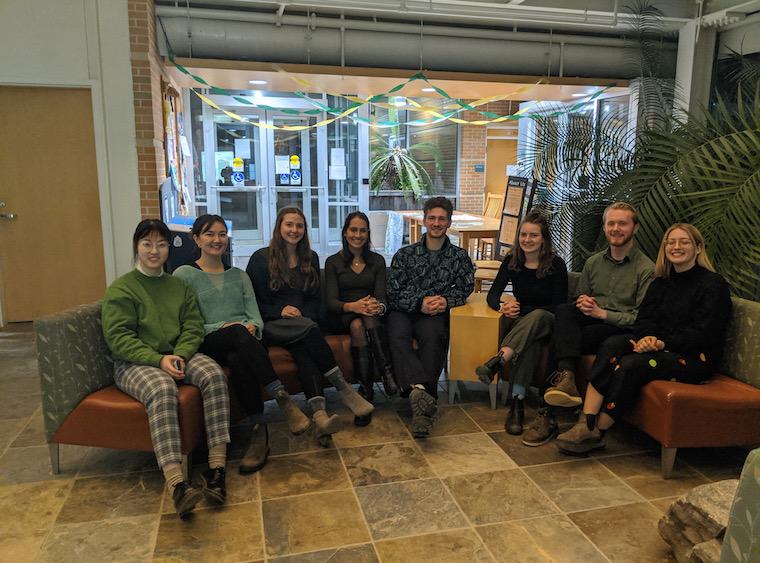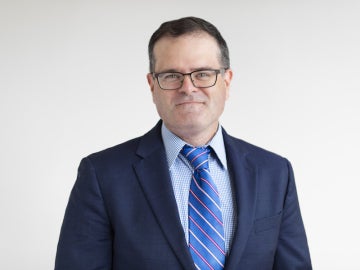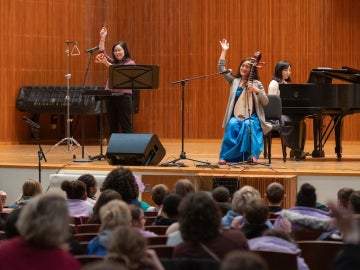Talking Sustainability with Oberlin’s Green EDGE Fund
November 13, 2020
Kyra McConnell ’22

Green Edge Fund board members gather in the atrium of the Adam Joseph Lewis Center for Environmental Studies.
Photo credit: Courtesy of Green Edge Fund
October was Sustainability Month at Oberlin, and no group is more dedicated to its celebration than the Green EDGE Fund . Composed of 10 student board members, the organization distributes funds to community-based projects dedicated to environmental sustainability.
Equipped with a new website and social media channels, the group has worked all semester discussing and approving new ideas submitted by Oberlin students, faculty, and community members, who faced an early November proposal deadline.
“We’ve been pretty busy,” said GEF chair Hannah Scholl ’21, who expressed excitement about a new pilot program in partnership with Oberlin Community Services, which harvests produce from local farmers for use in the Oberlin community. The program launched in summer 2020 and will continue into the winter and spring.
“It was very successful. We’ve been talking a lot about the importance of building community resilience, not only environmentally speaking, but in this age of the pandemic and thinking about ways we can support the Oberlin community,” said Scholl.
Supporting the Oberlin community is what the GEF does best. Projects vary in size and scale, from smaller endeavors such as public composting bins to larger tasks such as retrofitting new lighting systems for buildings, the current undertaking of Stephan Ciulla ’21, the GEF’s Office of Sustainability liaison.
With the help of a fund set aside for efficiency loans, Ciulla is working to ensure the installation of LED bulbs and modernizing the lighting controls throughout the Oberlin College Science Center, which he says accounts for 3 percent of the total amount of energy the town uses. When the retrofit is complete, the funding provided for the project will come back to the GEF through the savings the college realizes in its electricity use and will then be used to support future projects. Other buildings that benefit from energy-efficient retrofits include Mary Church Terrell Library and Stevenson Hall.
No matter the size of the project, the GEF’s main goal is the betterment of both the college and the town in tandem. For example, the Environmental Dashboard monitor, display, and educational programming provides an inside look into Oberlin’s collective efforts toward carbon neutrality, and the GEF recently funded monitors for Oberlin’s newest public school. GEF also secured funding for bike fix-it stations outside the local middle and high schools.
For Ciulla, these projects lie at the core of the town-college connection. “At the end of the day, it’s a really symbiotic relationship we have with the town, and providing our resources and making Oberlin College’s resources available to the public further strengthens that relationship into one that improves and builds upon social equity,” he said.
Social equity is a founding principle of sustainability. For the GEF board, sustainability takes on social, economic, and environmental forms, but always comes down to the “equitable access of resources,” according to Ciulla. “We ask how we can distribute resources to make sure that everyone has a fair chance in our community,” he said.
Scholl emphasized that anyone can partake in the efforts toward a greener future.
“We want to debunk the idea that sustainability is elite and posh and something that only certain people can achieve if they pay a lot of money and buy certain environmentally-friendly products,” she said. “It’s a community-driven system. Things like community gardens, growing your own food, or biking when you don’t have a car are sustainability at its core. It’s about meeting people where they’re at.”
You may also like…
Josh Nolan Named Vice President, General Counsel, and Secretary at Oberlin
Distinguished attorney brings extensive experience in higher education law.
Learning by Teaching: Oberlin Students Share Global Music with Young Learners
College and Conservatory students in PACE 103 prepare local children for an immersive community concert at Oberlin.
Nuiko Wadden ’02 Joins Oberlin Conservatory Faculty as Assistant Professor of Harp
The versatile musician brings extensive opera, orchestral, and contemporary music experience to her role


